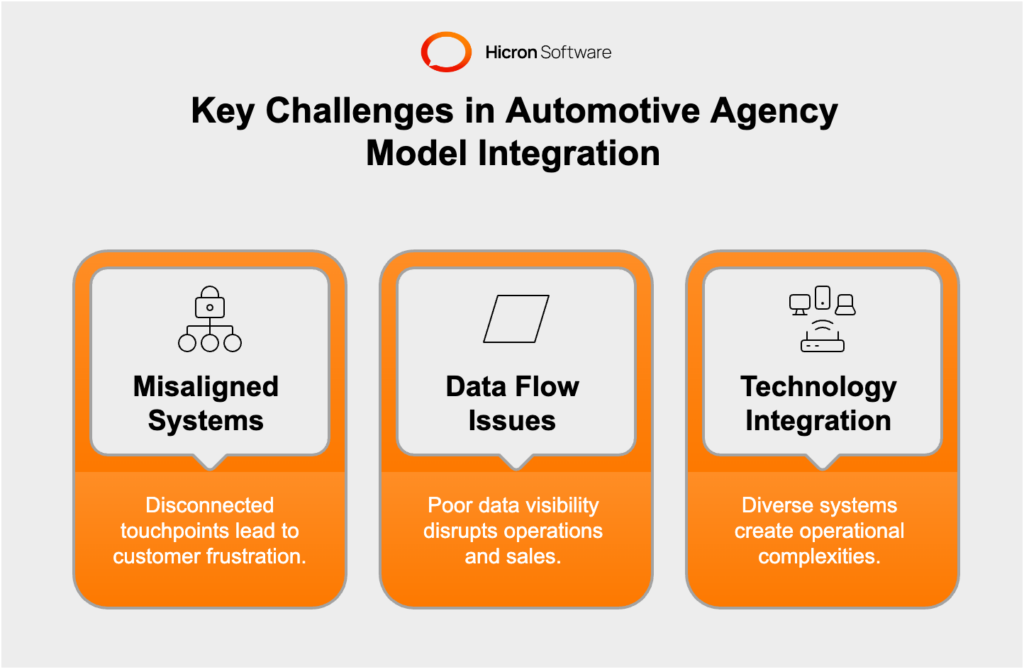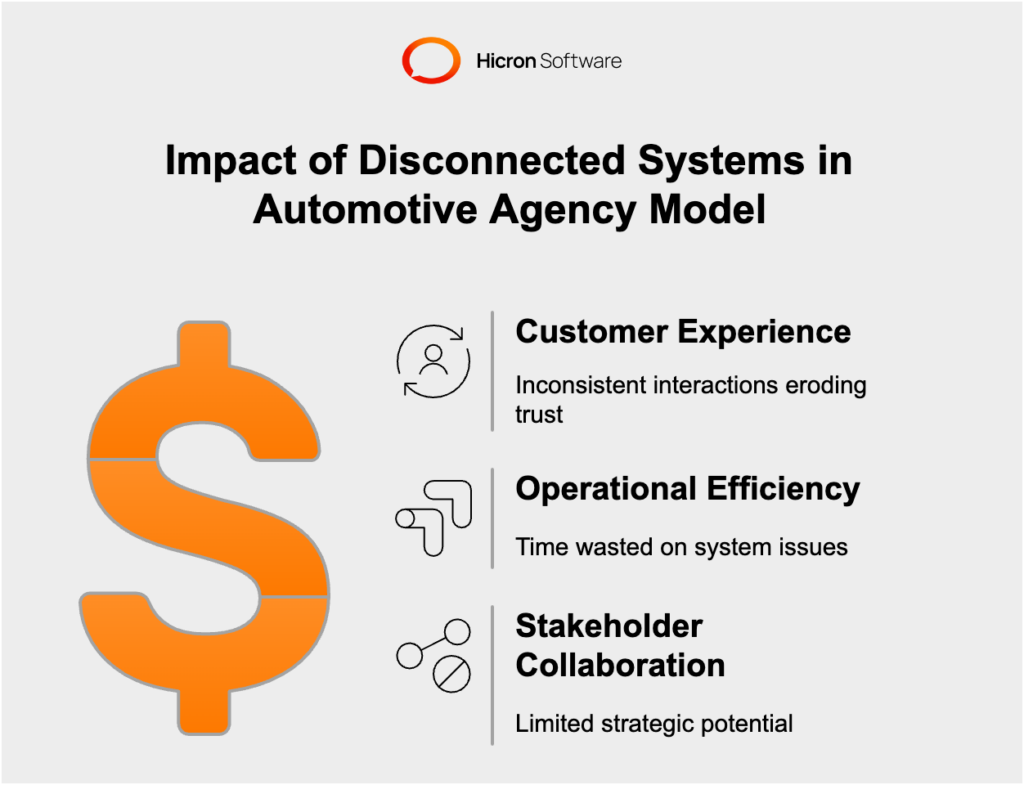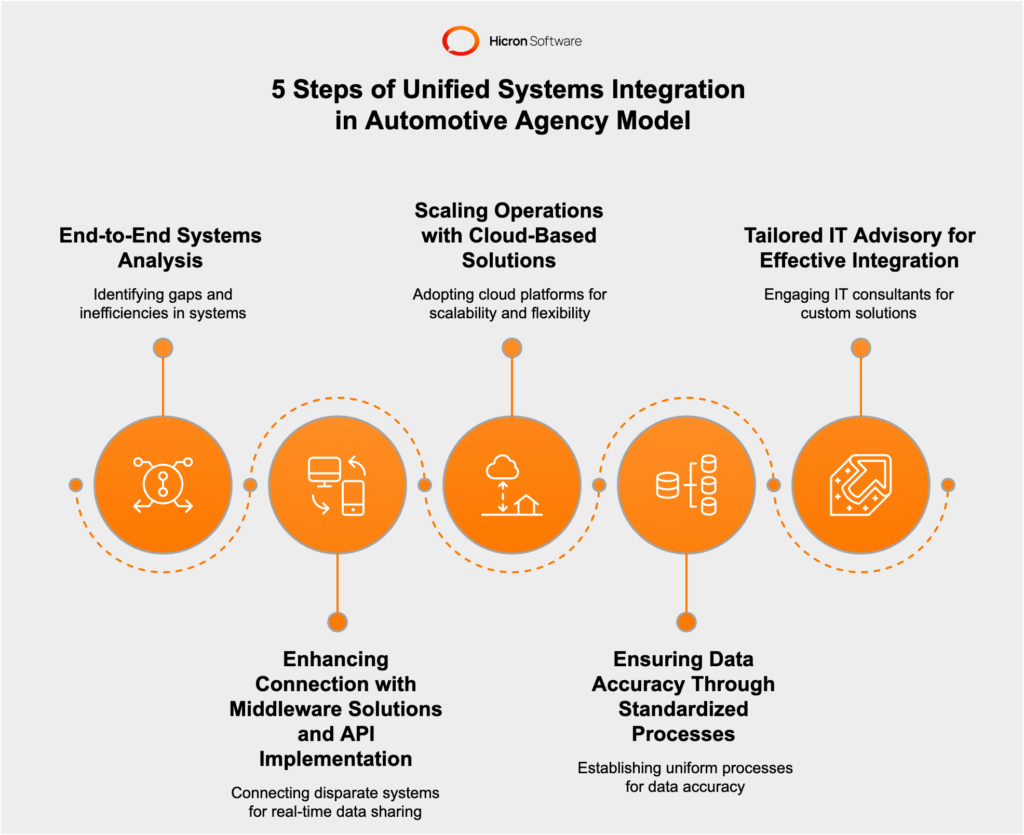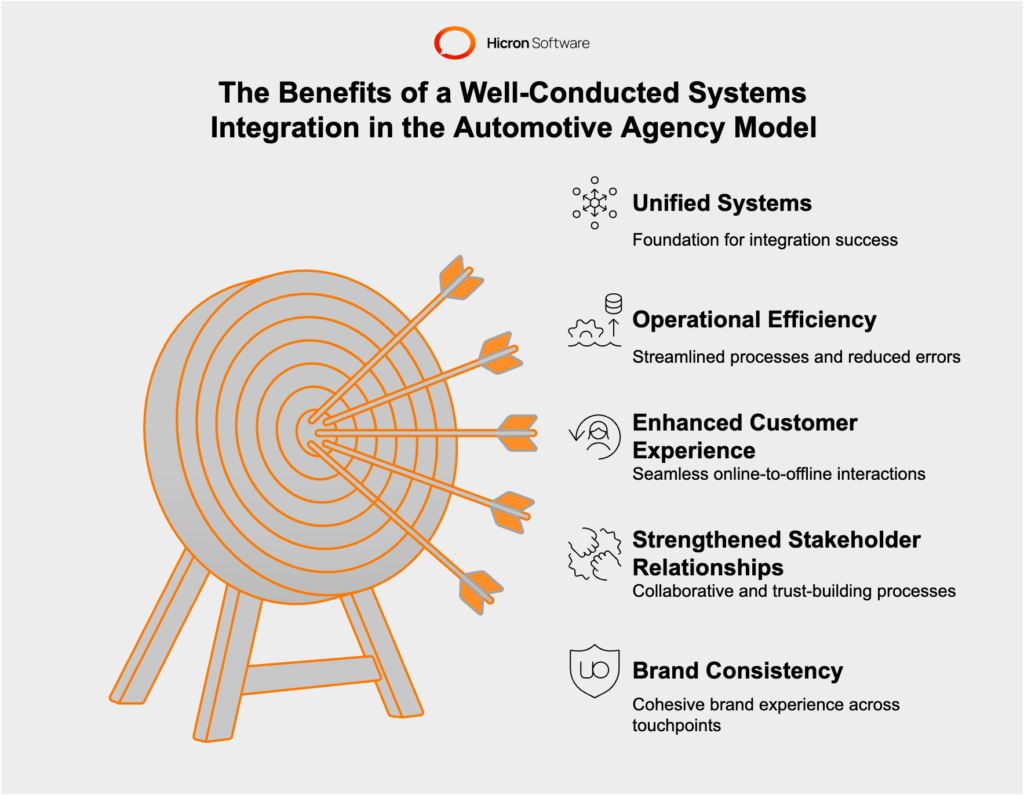Best Practices for Managing Automotive Warranty and After-Sales Services
- February 15
- 9 min

The automotive agency model is reshaping the industry, creating a new framework redefining how manufacturers, dealers, and customers interact. By shifting towards a more customer-centric approach, the automotive agency model unlocks opportunities for streamlined operations and enhanced consumer experiences.
However, the success of this transformation depends heavily on effective systems integration. When systems fail to align, the automotive agency model can face critical challenges such as disconnected processes, inconsistent customer journeys, and operational bottlenecks.
Achieving satisfying integration is not just an operational goal—it’s the backbone of the automotive agency model’s success. Unified systems ensure that every touchpoint works cohesively to deliver a flawless experience, meeting the expectations of today’s connected consumers. Thoughtful and strategic integration is the key to unlocking the full potential of the automotive agency model and creating a truly unified and scalable operational framework.
Effective systems integration is the backbone of the automotive agency model, but achieving it is no small feat. Businesses face several core challenges as they attempt to unify their operations.

Here’s a closer look at some of the most pressing issues:
Disconnected touchpoints occur when key customer and operational ecosystem elements fail to communicate effectively. Within the automotive agency model, this challenge can arise from siloed systems that don’t share critical information consistently or accurately across platforms. For example, a customer might configure their dream car online using a manufacturer’s car configurator, only to find that the specifications don’t align when they visit a dealership. Missteps like these not only disrupt the customer experience but also point to deeper integration gaps.
One key reason for such disconnections is the complexity of managing multiple technologies. When OEMs introduce tools like car configurators, these must work seamlessly with various systems used by dealers, such as inventory management platforms, Customer Relationship Management (CRM) software, and Enterprise Resource Planning (ERP) tools. Without proper integration, errors frequently occur. These might include incorrect specifications being transmitted, delays in real-time updates regarding availability, or mismatched pricing.
For customers, an inconsistent experience undermines trust. When they can’t rely on the data provided during their purchase process, frustration grows, increasing the likelihood of abandoning a sale altogether. For dealers, disconnected systems mean more manual work to fact-check and align data, leading to inefficiencies and lost productivity. OEMs, in turn, risk losing brand equity as they struggle to deliver a smooth, cohesive buying experience.
These fragmented touchpoints also make collaboration between stakeholders more challenging. Dealers may feel strained as they bridge gaps left by poorly integrated OEM systems, and customers often see the dealer as the bottleneck, even though the problem originates further up the chain.
Addressing this challenge is critical for the success of the automotive agency model. The agency model relies heavily on centralized control and a consistent experience across all customer journeys—from online browsing to in-dealership interactions and post-sale touchpoints. Disconnected systems undermine this vision, creating a patchwork experience that confuses customers and exhausts stakeholders. Building cohesive, integrated touchpoints is the backbone of a successful, scalable agency model.
Effective and accurate data flow is at the heart of any successful automotive agency model. However, ensuring that data moves in real time across platforms used by dealers, OEMs, and finance partners presents a challenge. Whether it’s inventory management, order tracking, or financing approvals, even small gaps in data visibility can lead to major disruptions.
1. Inventory Discrepancies: One of the most notable issues arises from the lack of synchronization in inventory systems across platforms. For instance, a car available on a dealer’s system may have already been sold or reserved in the OEM’s master inventory. This type of miscommunication leaves customers in a frustrating situation, especially after they’ve invested time and effort into selecting a vehicle. Dealers too are left managing expectations and often have to apologize for mistakes outside their control, damaging trust and confidence in the process.
2. Outdated Financing Information: Financial approvals require up-to-date and accurate information from all stakeholders, including finance companies, OEMs, and dealers. Delays become inevitable when systems fail to transmit the latest financial policies, eligibility terms, or loan approvals. Consider a buyer confident about a financing offer seen online, only to find out later at the dealership that the terms have changed. Such situations jeopardize the sale and degrade brand loyalty over time.
3. Communication Breakdowns Across Stakeholders: Dealers, OEMs, and finance partners operate with a variety of software systems and processes. These systems often fail to communicate effectively, leading to critical breakdowns in data sharing. For example, marketing data collected by OEMs may not align with customer details recorded by dealerships. As a result, essential insights like customer preferences, histories, and feedback do not translate into actionable, coordinated strategies, negatively impacting the overall customer experience.
The consequences of poor data management ripple through every stage of the customer trade lifecycle. These inefficiencies, from delays in processing transactions to inaccurate offers and conflicting information during the sales process, frustrate customers and tarnish their experience. Internally, dealers and OEMs struggle with wasted time and resources while attempting to realign mismanaged data, slowing down operations and reducing profitability. The lack of reliable communication erodes stakeholder collaboration, creating friction where seamless cooperation is vital for success.
To realize the full potential of the automotive agency model, businesses must tackle these challenges head-on. Implementing centralized platforms capable of synchronizing data in real time is vital. Leveraging advanced tools like cloud-based solutions and APIs can enable cohesive data exchanges while ensuring accuracy. By solving data flow and visibility challenges, the automotive industry can improve operational efficiency, strengthen stakeholder collaboration, and, most importantly, provide a superior customer experience that sets the foundation for long-term success.
Integrating a variety of technology systems across a wide dealer network is one of the most complex challenges businesses face when implementing the automotive agency model. CRM platforms, enterprise solutions, and legacy technologies often coexist within the same ecosystem, creating significant obstacles in achieving smooth and unified operations. Dealers, OEMs, and other stakeholders must bridge gaps between these systems to ensure consistency and efficiency, but the task is easier said than done.
1. Compatibility Issues Between Systems: Many dealers rely on outdated, region-specific software or legacy systems that were never designed to integrate with modern solutions. For instance, a dealership in one region may use an older CRM that lacks API compatibility with the OEM’s newest platform. This lack of connectivity makes it difficult to synchronize critical information like customer data, vehicle availability, and sales performance. The result is fragmented operations where key insights are siloed, limiting the ability to deliver a consistent customer experience.
2. Inefficiencies From Outdated Systems: Legacy systems may still serve essential functions within dealer environments, but their outdated architecture often slows down processes. For example, a dealer network relying on a decades-old inventory management system might struggle to update vehicle status in real time. This delay leads to errors such as cars being marked “in stock” hours or even days after they’ve been sold. Additionally, employees are often forced to manually transfer data between systems, leading to wasted time and increased room for errors.
3. Aligning Regional Dealer Processes: Dealer networks often span regions, each with unique regulatory requirements, market trends, and operational processes. These differences mean that integrating technology systems isn’t just about connecting platforms—it also involves adapting systems to accommodate varying workflows. For instance, a European dealership may prioritize compliance features for stringent emissions regulations, while a North American dealer may focus more on financing and payment options. Standardizing these processes across the network while respecting regional differences adds another layer of complexity to integration efforts.
The fragmentation caused by incompatible or outdated systems has far-reaching effects on an organization. Operational bottlenecks slow down processes like sales, inventory management, and after-sales services. The resulting inefficiencies increase operational costs and prevent dealers from scaling their efforts to meet growing demands.
These issues translate to inconsistent and frustrating experiences for customers, such as delayed responses to inquiries, mismatched offers, or incomplete service histories. Beyond immediate customer dissatisfaction, these problems also hinder the seamless collaboration between dealers, manufacturers, and finance partners that is vital for the automotive agency model to function effectively.
Transitioning away from outdated, standalone tools to cloud-based platforms and modular solutions is one way to address these hurdles. Implementing unified dashboards and centralized data repositories allows all stakeholders—dealers, OEMs, and finance partners—to access and update information seamlessly. Advanced integration tools such as middleware and intelligent APIs can also serve as bridges, ensuring that legacy systems can still play a productive role in the larger ecosystem. By prioritizing modern and adaptable solutions, businesses can effectively align their technology networks, enhance operational efficiency, and deliver the unified customer experience that is central to the success of the automotive agency model.
The ripple effects of these challenges cannot be overstated. Disconnected systems lead to disrupted customer journeys, where buyers are met with inconsistent experiences that erode trust and loyalty. Operational inefficiencies emerge as staff waste valuable time troubleshooting misaligned systems instead of focusing on core business functions. Finally, collaboration between key stakeholders—dealers, OEMs, and financing partners—is hindered, limiting the strategic potential of the automotive agency model. Overcoming these challenges is paramount to building a modern, unified approach that delivers on the promise of a seamless, customer-centric automotive experience.

Creating a unified and efficient automotive agency model requires deliberate steps toward aligning diverse and complex systems. Here are five actionable solutions that can help organizations achieve seamless integration and overcome the challenges of disconnected systems.

Before launching any integration effort, it’s essential to understand the current state of your systems. An end-to-end systems analysis identifies gaps, inefficiencies, and potential bottlenecks within your existing technology infrastructure. This detailed assessment helps organizations map out how data flows between platforms, uncover duplicate or outdated processes, and prioritize areas that need immediate attention.
For example, a dealer network might discover during analysis that its inventory management system is not synchronized with its CRM platform, leading to delayed updates on vehicle availability. Armed with this insight, it can focus integration efforts on bridging these specific gaps. End-to-end analysis thoroughly evaluates current workflows and technology and provides a clear blueprint for achieving integration.
Middleware solutions, Master Data Management and APIs (Application Programming Interfaces) play a pivotal role in connecting disparate systems without needing to replace legacy technology outright. Middleware acts as a translator, standardizing data formats and enabling smooth communication between incompatible platforms. Similarly, APIs enable real-time data sharing by allowing systems to “speak” to each other, even when they operate on different frameworks.
For instance, a dealership integrating its outdated CRM with the OEM’s modern customer portal could utilize middleware to ensure customer details are synchronized and updated across both platforms. This approach minimizes disruptions, optimizes data flow, and extends the life of existing systems while enabling them to operate within a unified framework.
Cloud-based systems offer unmatched scalability and flexibility for rapidly evolving automotive agency models. Unlike on-premise solutions, cloud platforms can expand alongside an organization’s growing needs, ensuring that data storage, processing, and application performance keep pace with increasing demands. They also enable real-time updates and accessibility, allowing stakeholders across regions to collaborate seamlessly.
For example, a global dealership network facing compatibility issues with local systems can adopt a cloud-based framework to unify all branches under a single, cohesive platform. Managing customer data, inventory, and financing becomes simpler since everyone involved can access the same reliable, up-to-date information. Cloud-based solutions help future-proof IT systems against emerging technological requirements.
Standardization is key to ensuring data accuracy and reducing inconsistencies across multiple touchpoints. Establishing uniform processes for data handling, communication, and system updates creates a stable foundation for great systems integration. Consistent workflows help prevent errors, such as mismatched vehicle specifications or outdated financing details.
For instance, a standardized protocol might require all dealers, OEMs, and finance partners to update customer records in real time within a centralized database. This ensures that every team member works from the same accurate dataset regardless of region or role. Organizations can minimize disruptions and deliver a flawless customer experience by maintaining process consistency.
Implementing unified systems integration often requires the expertise of IT advisory teams who understand the unique challenges of the automotive industry. Collaborative IT consultants can assess current systems, identify pain points, and recommend custom-tailored solutions that align with organizational goals. They also guide selecting the right tools and platforms to achieve a harmonious technology ecosystem without overspending.
Consider a scenario where an advisory team helps a dealership network struggling with siloed inventory and sales platforms. The team transforms the dealership’s fragmented systems into a unified, scalable network by devising a phased integration plan and recommending advanced middleware and cloud-based solutions. The result? Enhanced operational efficiency, reduced costs, and a streamlined customer experience.
As the industry continues to evolve, the ability to seamlessly connect processes, data, and technology is more critical than ever.
One major advantage of systems integration in the automotive agency model is the enhanced customer experience it delivers. Imagine a potential car buyer configuring their ideal vehicle online—choosing the color, interior materials, and additional features. Now, they visit a dealership, and instead of starting from scratch, the sales representative already has this information at their fingertips. This smooth transition from online to in-person interaction saves time, eliminates frustration, and ensures a personalized experience. By removing barriers, integration drives higher satisfaction and loyalty, both vital elements for the success of the automotive agency model.
System integration plays a crucial role in boosting operational efficiency within the automotive agency model. By streamlining processes, reducing errors, and enabling better communication between tools like CRM systems, inventory management platforms, and financing software, businesses can operate more effectively. Employees no longer waste valuable time reconciling data from disconnected sources. Instead, faster approval processes, smoother vehicle deliveries, and clearer communication create a more productive and agile work environment. These efficiencies are vital to the competitiveness of the automotive agency model, where every second counts in delivering exceptional service.
Seamless systems integration strengthens relationships among key stakeholders—dealers, OEMs, and financiers—within the automotive agency model. When systems share data effortlessly, financing decisions are expedited, inventory levels are optimized, and all parties can focus on delivering a unified customer experience. For instance, an OEM can communicate updated sales expectations instantly to dealers, ensuring alignment across the network. This collaboration fosters trust and minimizes delays, which is essential for the success and growth of the automotive agency model.
Brand consistency is a foundational principle for OEMs operating within the automotive agency model. Integrated systems allow them to provide a cohesive experience across both digital and physical customer touchpoints. For example, unified platforms enable OEMs to oversee marketing campaigns, ensuring that every dealership reflects consistent messaging. Additionally, detailed monitoring of customer interactions helps OEMs tailor service strategies while maintaining brand integrity. This control over the customer experience fortifies trust and connects consumers more deeply with the automotive agency model.
A unified system creates operational efficiencies, elevates the customer experience, and fosters collaboration among stakeholders—all critical factors for success in today’s automotive market. Implementing systems integration transforms how businesses handle every aspect of their operations, paving the way for a scalable and customer-centric approach. The automotive agency model thrives on the strength of these integrated systems, which lay the groundwork for long-term innovation and growth.

Now is the perfect time to evaluate your current systems integration processes within the framework of the automotive agency model. Are your tools and platforms enabling smooth collaboration between dealers, OEMs, and financiers? Is your customer experience seamless across online and in-person interactions? These are critical questions to consider as the automotive agency model evolves. Identifying gaps in your integration process can uncover opportunities to streamline operations, strengthen stakeholder relationships, and deliver exceptional customer experiences.
This is where partnering with a trusted expert becomes invaluable. With our tailored IT advisory and systems integration services, we specialize in helping businesses like yours transform disconnected systems into a cohesive network that aligns perfectly with the automotive agency model. From evaluating existing infrastructure to implementing cutting-edge solutions, we’ll work closely with you to design a strategy that addresses your unique challenges and positions your business for long-term success.
The automotive agency model is reshaping the industry. Staying ahead of the competition means more than adapting—it means thriving by exceeding customer expectations with innovative and integrated solutions. Don’t wait to take action. Addressing integration challenges now can secure your place as a leader in the automotive agency model and set the foundation for a future-proof business. If you’re ready to overcome systems integration challenges and build a superb automotive agency model experience, we’re here to help. Contact us today to start your transformation and drive success for years to come.
